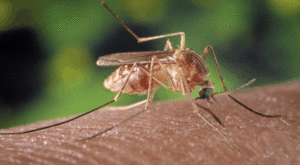Infectious diseaseConfusing mosquitoes to fight mosquito-borne disease
Female mosquitoes are efficient carriers of deadly diseases such as malaria, dengue and yellow fever, resulting each year in several million deaths and hundreds of millions of cases; to find human hosts to bite and spread disease, these mosquitoes use exhaled carbon dioxide as a vital cue; a disruption of the vital carbon dioxide detection machinery of mosquitoes, which would help control the spread of diseases they transmit, has been a long sought-after goal; University of California-Riverside scientists find a way to do just that

Culex quinquefasciatus - bringer of the West Nile virus // Source: clinmedres.org
Anandasankar Ray’s lab at the University of California – Riverside identifies odor molecules that hamper mosquitoes’ host-seeking behavior; research paves way for producing new generations of insect repellants and lures.
Female mosquitoes are efficient carriers of deadly diseases such as malaria, dengue and yellow fever, resulting each year in several million deaths and hundreds of millions of cases. To find human hosts to bite and spread disease, these mosquitoes use exhaled carbon dioxide as a vital cue. A disruption of the vital carbon dioxide detection machinery of mosquitoes, which would help control the spread of diseases they transmit, has therefore been a long sought-after goal.
A UC Riverside release reports that Anandasankar Ray, an assistant professor of entomology at the university, and colleagues report in the 2 June issue of Nature (it is the issue’s cover story) that they have identified in the lab and in semi-field trials in Africa three classes of volatile odor molecules that can severely impair, if not completely disrupt, the mosquitoes’ carbon dioxide detection machinery.
The breakthrough research covers three of the deadliest species of mosquitoes: Anopheles gambiae (spreads malaria), Aedes aegypti (spreads dengue and yellow fever), and Culex quinquefasciatus (spreads filariasis and West Nile virus).
The odor molecules that the researchers identified work by affecting the mosquitoes’ carbon dioxide receptors, which are located in tiny, antennae-like appendages — called maxillary palps — close to the mouths of the mosquitoes.
The three classes of the odor molecules are:
- Inhibitors: Odor molecules, like hexanol and butanal, that inhibit the carbon dioxide receptor in mosquitoes and flies.
- Imitators: Odor molecules, like 2-butanone, that mimic carbon dioxide and could be used as lures for traps to attract mosquitoes away from humans.
- Blinders: Odors molecules, like 2,3-butanedione, that cause ultra-prolonged activation of the carbon dioxide sensing neurons, effectively “blinding” the mosquitoes and disabling their carbon dioxide detection machinery for several minutes.
“These chemicals offer powerful advantages as potential tools for reducing mosquito-human contact, and can lead to the development of new generations of insect repellents and lures,” said Ray, who led the study. “The identification of such odor molecules – which can work even at low concentrations, and are therefore economical – could be enormously effective in compromising the ability of mosquitoes to seek humans, thus helping control the spread of mosquito-borne diseases.”
Female mosquitoes spread disease by first obtaining a blood meal from an infected person and subsequently finding an uninfected person to bite. Extremely sensitive
